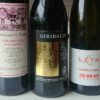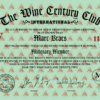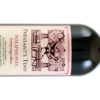Mollard – Preservation of a Vine Variety

Try to find the name of the grape variety – Mollard – in any book of vine varieties even in those by Pierre Galet and you will be unlucky. It is one of those vines that have almost passed into oblivion. But like the Phoenix, it is now beginning to rise from the ashes thanks to a few dedicated individuals and ENTAV (The National Technical Establishment for the Improvement of Viticulture).
Mollard was well known in the Hautes-Alpes prior to the invasion of phylloxera in the 1870s. At this time the Hautes Alpes had nearly 6000 hectares under vine, today it is under 200. For Mollard the decline has been even worse; even as late as 1958 there were still nearly 300 hectares grown in this French Department. Currently there are just 25 hectares under cultivation.
Its origin is the Hautes-Alpes (05) and it is believed to be a mutation from the Goulais Blanc. Mollard is a red skinned variety vitis vinifera that adapts itself well to the cooler climates of the Alpes. (Embrun is over 860 metres and Gap 740 metres above sea level). Back in 1868 Dr. Guyot in his book “Studies on French Grape varieties” stated “I find it (Mollard) fresh, with moderate alcohol, a good garnet colour and easy to drink. It is somewhere between a Mondeuse (Savoie) and a Gamay Noir (Beaujolais) in terms of aroma.”
The characteristics of this vine are:
1. Its ability to adapt itself to the soil conditions and the climate of this mountainous area and in the rift valley of the River Durance.
2. It is late in bud-break, thus avoiding many of the problems of late spring frost and snowfalls.
3. It ripens fairly late in the season, loving the long warmish autumn days.
4. It is only a little sensitive to coulure and is easily treated against both oidium and mildew.
5. The bunches are close knit and most commonly almost cylindrical, whilst the berries are of medium size and round in shape.
6. The wine produced is rich, with aromas black plums, a little tar, and some earthiness. (The term used locally is ‘rustique’).
7. The younger vines produce grapes that are well suited to the production of the ‘Vin de l’Année’ wines, whist the grapes from older vines produce wines that are best drunk after 2 – 4 years.
Marc Allemand of Domaine Allemand in Theus (05) in collaboration with ENTAV has just completed a 10 years study on this old vine. 2005 saw the beginning of the results of this study with the acceptance of a ‘mother vine’ with which to produce grafts to begin the preservation of the species. Two of the dozen or so clones were accepted by ENTAV and in 2007, 2000 ‘new’ vines were produced – most of which have been planted in his own vineyards. The production is guaranteed as ‘virus free’. In 2009 it is hoped that a ‘small’ number of grafted vines will become available commercially.

Speaking with Marc Allemand he told me, “I started getting the ‘bug’ about Mollard when I was still at school, and it developed further when I joined my farther after graduation. It has become my second ‘wife’, what with all the meetings, discussion groups, seminars etc. that it was necessary to attend to get as far as we have done until now. My greatest joy is that now ‘Cepage Mollard’ is allowed to be stated on my Vin de Pays wine label for my ‘vieilles vines’ red wine, I am currently the only one but it will not be long before a few of my fellow Vignerons will follow. There is another grower in the next village also producing a 100% Mollard wine.”
Question – “What do see as the future for Mollard?”
Answer – “It is an ideal grape variety for those wishing to produce red wines in the cooler climates of the world. It is certainly nowhere near as temperamentally difficult, shy bearing, or as prone to mutation as the pinot noir. Being virtually unknown it offers a new choice to both producer and, hopefully, consumer. Mollard is already being regarded with interest by the Swiss, and in a small way by other small northern producing countries who wish to offer something different to the cabernets, merlots, syrahs and grenaches. But my main interest is in the preservation of ancient varieties that can produce quality wines. So many have already been lost and our ‘big brother’ in Bruxelles is not easy to convince that some tiny varieties of anything are worth retaining. I am also a qualified distiller producing spirits from both grape pomace and fruit ‘eaux de vie’ so I understand it from both the vine and fruit grower’s point of view”.
Question – “Could this be another viognier?”
Answer – “I would love it to be, but somehow I don’t think so. For Mollard there are too many attributes that are similar, some in a tiny way, to other red wine varieties. But with more countries further north in Europe, perhaps Canada and higher regions in Chile and Argentina, and others in hilly regions, wanting to produce red wines with a difference, hopefully there may be a few that will give the Mollard a chance.”
Question – “Is anything being done to publicize the Mollard and its acceptance?”
Answer – “A film, due for release in late October in French, has been made about the vine varieties of the Hautes Alpes. Part of the film was shot here in my vineyards. I will ensure you are invited to its premiere”.
Question – What date and what is the quantity and quality of the 2008 harvest?
Answer – “The best example I can show you is where I have three ages of Mollard in a small parcel of wines at Espinasses (the next village). Harvest will be later than usual as we have not had a great deal of sun (unusual for the valley). The Mollard has lived up to its reputation of not having too many problems with rot and I have done only a limited amount of spraying. The quantity is around average and the quality – good to very good – if we get some late afternoon sunshine. The vintage will start in early October.”
Visiting the one remaining wine co-operative in the Department at Valserres (05), I enquired of the new manager, M. Millot, a young graduate oenologist from Montpellier, if any of the members produce a listed Molllard wine. He told me, “At present there is only one co-operative producer in the Hautes Alpes, producing a 100% Mollard wine, the rest of the members only have tiny amounts of Mollard remaining, so therefore it is it blended into our Vin de Pays des Hautes Alpes rouge.
The one area where there is the opportunity for expansion of Mollard wines is in the growth of the ‘all the year round’ tourist market, but are the ‘powers in office’ capable (or willing)’ to back the small vineyard industry of this department, or will the French anti-drink lobby fire another shot in the foot of the country’s wine industry?
Article and photographs copyright Grahame Martin.







Happy Birthday, I had a bottle of Penfolds Grange1995 Shiraz and I shared it with my friends. Always an excellent wine to celebrate vertually anything.
bonjour je suis tres ravi de decouvrir votre ancien cepage molard,pouvez vous me donner les indications pour en acheter.ecoute je suis un quebecois qui travaille dans le vigne depuis 2005 ds 81 je vais au quebec regulierement. alors si j’avais 3 plans c’a serait ok. merci de me repondre
mr.vadnais
I always love it when vintners try to keep the ancient varietals alive. It’s always great to try new varietals!
Je suis ravie d’apprendre qu’il y a une variete de ce nom, tres peu connu en Angleterre ou j’etais nee. Nous sommes peut-etre une douzaine qui ont ce nom ici, mais des amis francais nous a dit que le nom est connu en Savoie.
On connait bien deja Moillard, en Bourgogne.
We are travelling to France in early August for the wedding of some friends and we shall seek out this variety without delay. Where can we buy it? Do you have any history of the name?